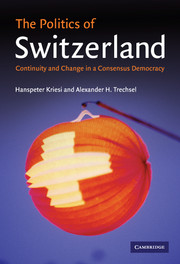Book contents
- Frontmatter
- Contents
- List of figures
- List of tables
- Preface
- List of abbreviations
- 1 The development of the modern Swiss nation-state
- 2 Neutrality
- 3 Federalism
- 4 Direct democracy
- 5 The Swiss system of government
- 6 The party system
- 7 Interest associations and labour relations
- 8 The decision-making process
- 9 Economic policy: liberalization under constraints
- 10 Social policy: the Swiss welfare state
- 11 Foreign policy: Switzerland and the EU
- Appendix
- References
- Index
10 - Social policy: the Swiss welfare state
Published online by Cambridge University Press: 05 September 2012
- Frontmatter
- Contents
- List of figures
- List of tables
- Preface
- List of abbreviations
- 1 The development of the modern Swiss nation-state
- 2 Neutrality
- 3 Federalism
- 4 Direct democracy
- 5 The Swiss system of government
- 6 The party system
- 7 Interest associations and labour relations
- 8 The decision-making process
- 9 Economic policy: liberalization under constraints
- 10 Social policy: the Swiss welfare state
- 11 Foreign policy: Switzerland and the EU
- Appendix
- References
- Index
Summary
Introduction
In his classic study, Esping-Andersen (1990) distinguishes between three ideal-typical worlds of welfare – a social-democratic, a liberal and a conservative welfare state. The social-democratic welfare state, typically represented by Scandinavian countries, is a generous, universalistic one that provides social security to all irrespective of gender, former employment status or nationality. Moreover, social services are provided by the state itself, which implies a large amount of public employment. The liberal welfare state, exemplified by the United States, is a residual welfare state of limited size which essentially constitutes the last resort for people in need, providing not much more than a minimal level of benefit. Social security over and above the basic safety net is left to individual initiative. Like the social-democratic model, the conservative or Christian-democratic welfare state, exemplified by the ‘Bismarckian’ or German model, is an onerous one. But it implies less public employment than the social-democratic model and mainly provides massive transfer payments with the aim of maintaining the social status which the beneficiaries have acquired during the period of active employment. Moreover, the conservative welfare state is oriented towards the maintenance of the family with one (typically male) breadwinner.
The Swiss welfare state has proved notoriously difficult to classify by reference to this threefold classification. Esping-Andersen himself considers it a liberal regime, while others refer to it as a Christian-democratic welfare state (Scharpf and Schmidt 2001; Huber and Stephens 2001), a ‘Western European welfare state with a liberal face’ (Armingeon 2001: 162), a mixed regime (Obinger 1998) or as a case of a welfare state ‘disciplined by Protestantism’ (Manow 2002).
- Type
- Chapter
- Information
- The Politics of SwitzerlandContinuity and Change in a Consensus Democracy, pp. 155 - 171Publisher: Cambridge University PressPrint publication year: 2008



